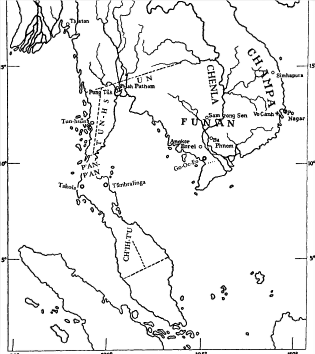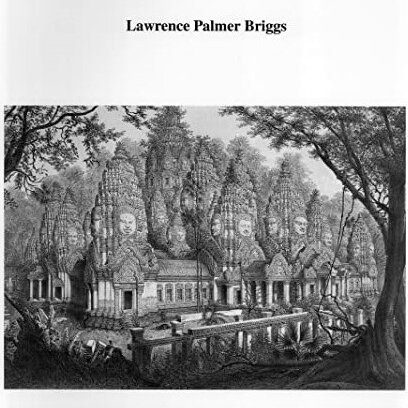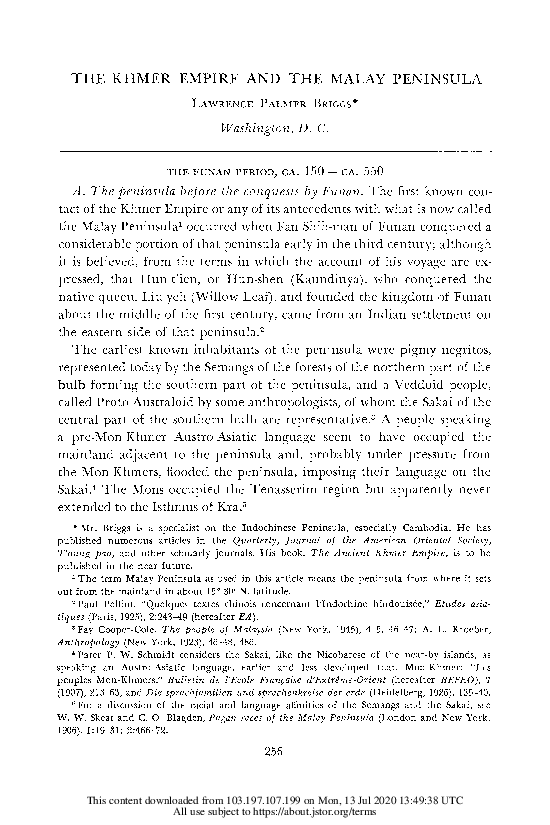The Khmer Empire and the Malay Peninsula
by Lawrence P. Briggs
From the Funan period to the peak of the Khmer Empire, the connections between Malay and Indochinese peninsulas.

Publication: The Far Eastern Quarterly, Vol. 9, No. 3, pp. 256-305 | Association for Asian Studies
Published: May 1950
Author: Lawrence P. Briggs
Pages: 50
Languages : English, Chinese
pdf 903.1 KB
Sea trade, invasions, political alliances between commercial emporia along the coastline: the interaction between Malay people, Mon-Khmer indigenous populations and Indian and Chinese settlers have been multiple and various since as early as the 3d century CE.
Among the many connections between the two peninsulas put forward by the author, we note that “a prince of Tambralinga seized the throne of Cambodia and conquered the Mons of the Menam and the peninsula (1002−50). The close relations between Kambujadesa and the Bandon region are historic. The basic populations of the two regions seem to have been essentially the same, and they seem to have spoken fundamentally the same language. The Bandon region was under the domination first of Funan and then of Chenla from the beginning of the third century until it was conquered by Srivijaya in the latter part of the eighth. After that conquest, the region from Kra to Kedah seems to have been known to the Arabs as Kalah, with a capital at Kedah, while the old partly-Khmerized kingdoms of the Bandon region retained their identity, subject to the suzerainty of San-foch’i (or Sribuza, as the Arabs called it), whose Malay ruler seems to have divided his time between Kalah and Sribuza.”
Note: useful glossary of Chinese regional names in appendix.
About the Author

Lawrence P. Briggs
Lawrence Palmer [“Larry”] Briggs (17 Oct. 1880, Manton, Wexford County, Michigan, USA — ?) was a US diplomat and independent historian who dedicated his major work to the Ancient Khmer Empire.
After graduating from University of Michigan in 1908, and teaching in Seattle (Washington State) in 1909-10, Briggs, the first “Native Sons” fellow at University of California [from the Orders of the Native Sons & Native Daughters of the Golden West, founded in 1875], was sent to Spain in 1911 – 2 to work in the Archivo General de Indias, Sevilla, in order to complete a thesis on the Spanish colonization of the Pacific coast. Charles Chapman [“The Native Sons’ Fellowships”, The Southwestern Historical Quarterly, Apr. 1918, 21 – 4: 389 – 394.] would later acknowledge Briggs’ “pioneer work” on the Archivo.
After a short assignment as Superintendent of schools, Briggs joined the State Department at the outbreak of WWI, serving as U.S. Consul in Saigon (1914−17), Rangoon (1918−20), Rivière du Loup (Quebec, Canada) (1920−22), Nuevitas (Cuba) (1924−29), and Bahia (Brazil) (1932-?). He seemed to have left the diplomatic service by 1945, as he signed “Retired American Consul” a residence card in Los Angeles on that year, yet his postings in Southeast Asia brought him to focus his passion for historical research on that region.
In the 1940s and early 1950s, L.P. published his research on Southeast Asia, in particular in The Journal of American Oriental Society and the Far Eastern Quarterly. Reviewing his major published work (The Ancient Khmer Empire, 1951) in 1953, George Coedès, who had met him in Cambodia, noted that L.P. Briggs had started working on the manuscript in 1943, collating more than 750 research items on the subject. “It is the first time that the already considerable body of research work relating to ancient Cambodia has been assembled, sifted and brought within reach to the English speaking public”, noted Coedès (“Review of The Ancient Khmer Empire by L.P. Briggs”, Diogenes 1 – 1, January 1953: 115 – 118).
“I am neither an anthropologist nor a linguist but I am writing a series of histories of certain countries of Indo-China, and the history of some of these countries extends into the prehistoric past,” he wrote in 1945 in an answer (JOAS 65 – 1, 1945, p 56), to a critic from Dr. Heine-Geldern — who would five years later write an elogious preface to his Ancient Khmer Empire. The short publication was dated ‘Berkeley, California’, an elusive indication on what he was doing after World War II, as his life from then remained shrouded in mystery.
L. P. Briggs was one of the first researchers to support the hypothesis that the mythical founding couple of Kambuja, Prince Kaundinya and Princess Soma, was inspired by a foundation myth from the Pallava kingdom of India. His latest known publication was his one and only contribution to the Bulletin de l’École française d’Extrême-Orient in 1952. The circumstances of his death and his burial location remain unknown.
Publications
[signed ‘L.P. Briggs’ or ‘Larry Briggs’]
- An historical review of the argument in favor of the right of the British Parliament to tax the American colonies, typescript, 1908, 64 p. (Hathi Trust).
- A pilgrimage to the home of Joseph de Galvez, the father of California, Oakland, Holmes Books Company, 1942, 28 p. [publication of a text dated London, June 1, 1912, privately printed in a limited edition of two hundred copies].
- A Pilgrimage to Angkor, ancient Khmer capital, Oakland, Holmes Books Company, 1943, 95 p.
- “How obsolete are the theories of Professor Dixon and Pater Schmidt?”, Journal of the American Oriental Society (JAOS) 65, 1945: 56 – 58.
- “Dvaravati, the most ancient kingdom of Siam”, JAOS 65, 1946 : 98 – 107.
- “Aubaret and the Treaty of July 15, 1867 between France and Siam”, FEQ 6 – 2, 1947: 122 – 138.
- “A sketch of Cambodian history”, Far Eastern Quarterly (FEQ) 6 – 4, 1947 : 345 – 363.
- “Review of R. C. Majumdar, Ancient Hindu colonies in the Far East”, FEQ 6, 1947: 420 – 430.
- “Notes on George Coedes, “Les Etats hinduises d’Indochine et d’Indonesia”, FEQ 7, 1948: 373- 376; “The Hinduised states of Southeast Asia; a review of George Coedes, ‘Histoire ancienne des etats hinduises d’Extreme-Orient’ “, ibid : 376 – 393.
- “Review of George Coedes, “Pour mieux comprendre Angkor””, FEQ 8, 1948 :115 – 116.
- “Siamese attacks on Angkor before 1430”, FEQ 8, 1948 : 3 – 33.
- “The appearance and historical usage of the terms Tai, Thai, Siamese and Lao”, JAOS 9, 1949: 60 – 73.
- Spanish Intervention in Cambodia 1593 – 1603, c. 1949 (shown as book in BNF catalogue).
- “The origin of the Sailendra Dynasty. Present status of the question”, JAOS 70, 1950: 76 – 89.
- “The Khmer Empire and the Malay Peninsula”, Far Eastern Quarterly (FEQ) 9, 1950: 256 – 305.
- “The place of architectural and sculptural motifs in determining the chronology of the Khmer monuments”, nd, unpublished typescript.
- “The syncretism of religions in Southeast Asia, especially in the Khmer Empire”, JAOS 71⁄4 (1951): 230 – 49.
- The Ancient Khmer Empire, Philadelphia, Transactions of the American Philosophical Society, New Series- Vol 41 – 1, 1951, 277 p.; repr. 1999, Bangkok, White Lotus, 295 p. ISBN 9748434931.
- “The genealogy and successors of Sivāchārya. Suppression of the great sacerdotal families by Sūryavarman I”, BEFEO 46 – 1, 1952: 177 – 185 [via persee.fr].

